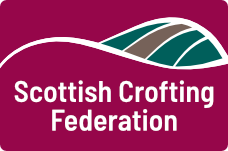About Crofting
Crofting is a land tenure system of small scale food producers unique to the Scottish Highlands and Islands. It provides tenants with security provided they pay their rent, live on or near their croft and work the land.
Why Crofting is good for Scotland
Designed to protect the people from exploitation by landlords in the 19th Century, crofting has a proven track record of maintaining population and economic activity in remote rural areas.
Crofting supports local food production while protecting the cultural heritage and the natural environment in the crofting areas.
Through its mix of arable and common grazing land, it encourages both communal working and individual enterprise.
How can I get a croft?
Few crofts come onto the market, whether tenancies or owner-occupancies. Those that do are generally in great demand. They are often advertised locally or in the property sections of newspapers such as the Oban Times, Stornoway Gazette, West Highland Free Press, Shetland Times, Northern Times or Press and Journal. Solicitors’ offices and estate agents handle such sales and can be approached directly to find out what might be available. A direct approach could also be made to estates within the crofting counties, as they might possibly have a vacant tenancy.
The consent of the Crofting Commission is required in any change of tenancy, whether by assignation by a tenant or by the re-letting of a vacant croft. A new owner-occupier is likewise liable to be subjected to scrutiny. The Commission will take into account local crofting demand and interests, and whether the proposed person intends to live on the croft and work it, and make a contribution to the local crofting community.
The SCF has a list of members who are interested in acquiring a croft. Each month we search for crofts that have become available and we email our RAC (Register of Available Crofts) to those on the list. It is then up to the member to research the suitability of the croft for their needs and get in touch directly with the appropriate agent. The list is maintained as a service for members only.
For more information or if you are interested in registering on the list, please contact our office on 01599 530 005 or email hq@crofting.org
A bit more about crofting
What is a crofter?
A crofter is the person who occupies and works a small landholding known as a croft. A crofter is normally the tenant of the croft, paying rent to the landlord of the croft. But many others have purchased their crofts and are owner-occupiers of their crofts.
What is a croft?
A croft is a small agricultural unit, most of which are situated in the crofting counties in the north of Scotland being the former counties of Argyll, Caithness, Inverness, Ross & Cromarty, Sutherland, Orkney and Shetland, and held subject to the provisions of the Crofting Acts.
Many crofts are on estates. A landlord may have many crofts on his estate. The rent paid by the tenant crofter, except in fairly rare circumstances, is only for the bare land of the croft, for the house and agricultural buildings, roads and fences are provided by the crofter himself. Since 1976 it has become more common for a crofter to acquire title to his croft, thus becoming an owner-occupier. Should he fail to reside on or near the croft, he can himself be required to take a tenant.
What are the Crofting Acts?
This is a series of Acts passed since 1886 providing security to crofters, protecting them from being unfairly removed from their land, guaranteeing fair rents and allowing them to claim compensation for improvements should their tenancy come to an end. The law of crofting was codified as the Crofters (Scotland) Act of 1993, but there have been substantial reforms, notably in 2007 and 2010 as part of the Scottish Government’s Land Reform Programme. Crofts are regulated by the Crofting Commission, who have their head offices in Inverness.
How big is a croft?
The average size of a croft is around 5 hectares, but some are only 0.5 ha while a few extend to more than 50 ha of land, often with a share in hill grazing which is held in common with other crofters in a township. Most crofts cannot support a family or give full-time employment, and most crofters have other occupations to provide the main part of their income. Many crofters have diversified into small-scale tourism and off-croft employment.
What type of land use takes place on a croft?
The main product is lamb and beef, which are sold on to lowland farmers for fattening and finishing, since this is not cost-effective in the west due to climatic and soil quality constraints. Some winter keep and potatoes may be grown across the area, and crofters are increasingly diversifying into horticulture, producing a wide range of seasonally available fruits, vegetables and plants. Interests in forestry, woodland management and renewable energy are also developing.
What is the Crofting Commission?
The Commission administers and regulates crofting and keeps under review all matters relating to crofting. It was recently changed from the Crofters Commission to the Crofting Commission to emphasize that its role is to regulate crofting.
